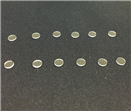

Time:2024-09-19
sapphireoptical elementAs a high-performance optical material, it plays a role in fields such as optical communication, healthcare, scientific research, and military aviation. Its mechanical properties, high infrared transmittance, excellent thermal shock resistance, and corrosion resistance make sapphire an ideal choice for making optical components. However, in order to ensure the stable performance and service life of sapphire optical components, the requirements during their use and storage are equally crucial.
1、 Usage requirements
1. Safety operating procedures
When using sapphire optical components, it is necessary to strictly follow safety operating procedures to ensure the safety of operators and equipment.
① Wear personal protective equipment: Operators should wear protective equipment such as goggles, gloves, and long sleeved clothing to avoid injury caused by accidental splashing of particles or debris during operation.
② Handle with care: Sapphire optical components are fragile and should be handled with care to avoid collision and falling. During the handling and installation process, specialized fixtures or gloves should be used to ensure that the lens surface is not directly touched by hand to prevent scratches or contamination.
③ Avoid overheating and overcooling: Sapphire has a high coefficient of thermal expansion, so prolonged exposure to high or low temperature environments should be avoided to prevent unwanted thermal stress and deformation. At the same time, sudden temperature changes such as rapid heating or cooling should be avoided.
④ Prohibit overload use: In high-power applications such as lasers, it should be ensured that sapphire optical components do not exceed their rated operating parameters to avoid component damage or shortened service life caused by overload use.
⑤ Follow the manufacturer's instructions: When cleaning, disassembling, and assembling sapphire optical components, strictly follow the manufacturer's instructions to ensure that each step complies with specifications to ensure the safety and performance of the components.

2. Cleaning and maintenance
The cleanliness of sapphire optical components has a direct impact on their performance, therefore regular cleaning and maintenance are necessary.
① Regular cleaning: Before and after use, sapphire optical components should be cleaned to remove impurities such as dust and oil on the surface. When cleaning, specialized dust-free cloths, cotton swabs, and suitable cleaning agents (such as anhydrous ethanol or acetone) should be used to avoid using items containing abrasive particles or corrosive components. During the cleaning process, gentle techniques should be used to avoid scratching the surface of the lens.
② Avoid direct contact: During cleaning and maintenance, try to avoid direct contact between fingers or tools on the surface of the lens to reduce the risk of contamination and scratches. If direct operation is required, dust-free gloves or finger cots should be worn.
③ Environmental control: The operating area should maintain a constant temperature and humidity, and be equipped with an efficient air filtration system to reduce the impact of dust particles in the air on optical components.
2、 Storage requirements
1. Storage environment
The storage environment of sapphire optical components is crucial for their long-term performance stability.
① Temperature stability: Sapphire optical components should be stored in a temperature stable environment, generally recommended at around 20 ℃, to avoid being affected by sudden changes in temperature and humidity.
② Humidity control: The relative humidity of the storage environment should be low to prevent components from getting damp or moldy. Moisture control can be achieved using devices such as moisture-proof cabinets.
③ Avoid light and dust: The storage area should avoid direct sunlight and dust accumulation to reduce damage to components from light and dust.
2. Storage method
① Separate storage: Each sapphire optical component should be stored separately in a dedicated container to avoid damage caused by collision or compression.
② Use specialized containers: Storage containers should be made of materials such as polycarbonate, PTFE, or PET-G, which have good moisture and dust resistance and will not cause chemical corrosion to components. Avoid using materials such as polypropylene that are prone to degassing.
③ Regular inspection: Sapphire optical components stored should be inspected regularly to ensure that their surfaces are free of stains, scratches, and other damages, and cleaned and maintained in a timely manner.
Sapphire optical components, as high-performance optical materials, play an important role in various fields of application. However, its superior performance also requires proper usage and storage methods to ensure. By strictly following safety operating procedures, regularly cleaning and maintaining, and creating a suitable storage environment, the service life of sapphire optical components can be extended, ensuring their stable and reliable performance.






Tel
Mobile phone
Customer service
TOP